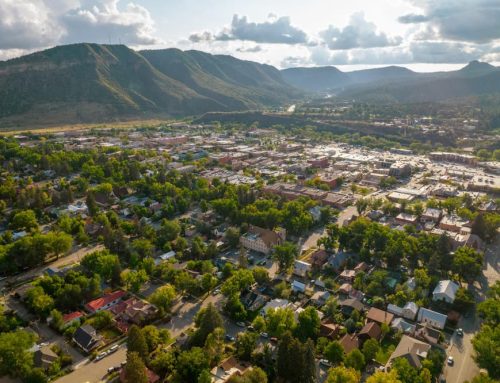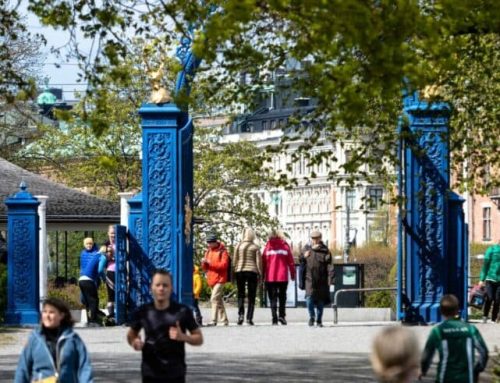Destination Stewardship Report – Summer 2021 (Volume 2, Issue 1)
This post is from the Destination Stewardship Report (Summer 2021, Volume 2, Issue 1), an e-quarterly publication that provides practical information and insights useful to anyone whose work or interests involve improving destination stewardship in a post-pandemic world.
It’s a destination described by one expert as having “one of the greatest, rural, natural resource-based economic development programs in the U.S.” The remarkable Pennsylvania Wilds joins our ongoing “Doing It Better” series on places with a holistic approach to destination management in the spirit of GSTC Destination Criterion A1. Over the past three years two DSC volunteers, Ellen Rugh and Jacqueline Harper, have been collecting and documenting information on the region’s remarkable PA Wilds Center.
Doing It Better: The Pennsylvania Wilds

A Pennsylvania Wilds landscape [Photo by Ellen Rugh]
Holistic Destination Regeneration, from Conservation to Design
This forested multicounty region in northwest Pennsylvania, once known as the “timber capital” of America, was depleted of its trees and wildlife by the beginning of the 20th century. Poor forest management and increased demand for lumber led to raging wildfires and floods. The elk population went extinct; the whitetail deer nearly so. With the timberlands denuded and an oil boom played out, the region went into decline. The government ended up buying the land to create state and national forests. Now, after 100 years of conservation, the elk are back, and the rebranded “Pennsylvania Wilds” has been restored, hosting a rich, thriving forest that educates others on the importance of responsible forestry.
One opportunity for regenerating the depressed region was tourism, focused on the area’s rejuvenated landscape, rich human history, and living artisanry. Facilitating that vision has been the Pennsylvania (PA) Wilds Center for Entrepreneurship (often shortened to the PA Wilds Center).
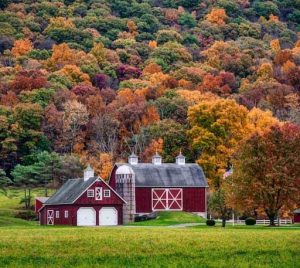
Breathtaking fall foliage behind an old PA Wilds barn. [Photo by Cameron Venti]
The PA Wilds initiative was launched in 2003 by then Governor Ed Rendell to coordinate the efforts of various state agencies and local stakeholders in an initiative to marry conservation and economic development. Ten years later, the non-profit PA Wilds Center for Entrepreneurship, Inc. was founded with support from the PA Department of Conservation and Natural Resources (DCNR) and PA DCED. The PA Wilds Center is a 501(c)(3) non-profit with the mission to “integrate conservation and economic development in a way that strengthens and inspires communities in the Pennsylvania Wilds.” Currently, the PA Wilds acts as the coordinating entity among local partners to promote a sustainable form of nature-based and heritage tourism, seeking to “celebrate and nurture our natural wonders by connecting people with nature.” According to their website, tourism in this region pre-pandemic has accounted for about 11% of its economy with a visitor spend of approximately $1.8 billion annually.
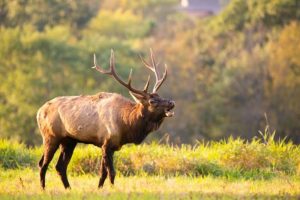
The largest wild elk herd in the Northeast lives in the Pennsylvania Wilds. [Photo by Matthew Schwartz]
Geographic Context
The Pennsylvania Wilds jurisdiction comprises 12 ½ counties in North-Central Pennsylvania and is one of the 11 official tourism regions designated by the Pennsylvania Department of Community & Economic Development (DCED) Tourism Office. Although the PA Wilds cover over a quarter of the state, it is home to a mere four percent of the state population. It covers 2.4 million acres of public land (more than Yellowstone National Park), most of which is working forest. The Pennsylvania Wilds boasts two National Wild & Scenic Rivers, 9 state and national forests, 29 state parks, the largest wild elk herd in the Northeast, and some of the darkest skies in the country. It has a rich heritage in oil and lumber. Now however, with the coordination of the PA Wilds Center, many local partners are involved in the growing push towards nature-based and heritage tourism to create jobs, diversify local economies, inspire stewardship, and improve quality of life.
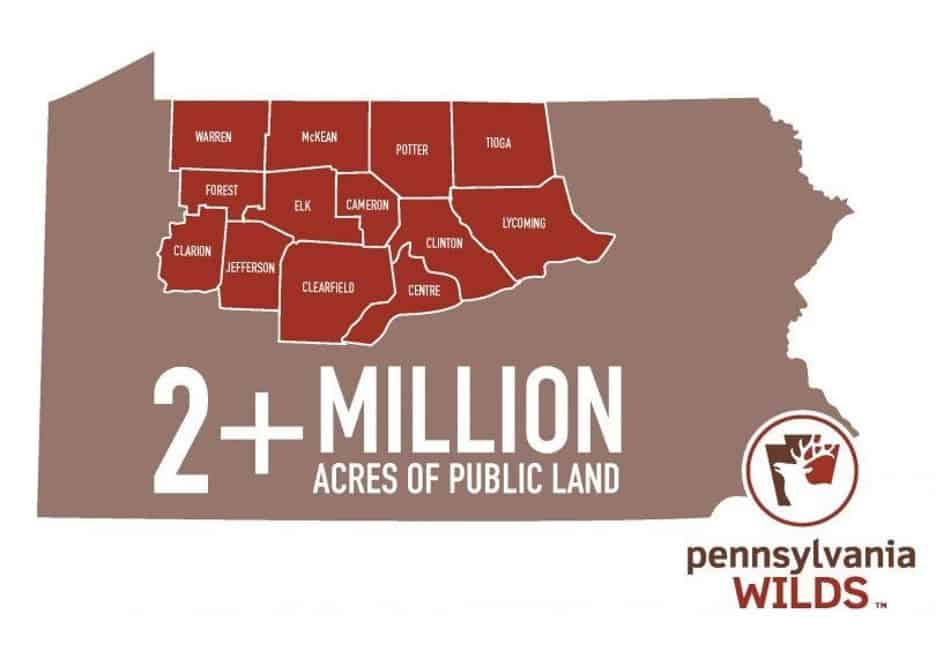
Source: PA Wilds Center website @ https://www.pawildscenter.org/about-us/
Activities
The PA Wilds Center uses strategic, coordinated regional planning to protect the region’s scenic quality, natural resource preservation, and individual community character. Several activities support this approach.
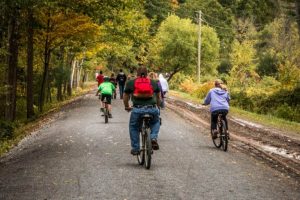
Bicyclists head south for a ride on the Pine Creek Rail Trail. [Photo courtesy of PA Wilds Center for Entrepreneurship Inc.]
• Visual Appeal – The PA Wilds Center wants new development to protect the region’s sense of place and community distinctiveness – whether that growth is due to tourism or other industries. With this in mind, the organization created the landmark PA Wilds Design Assistance Program, publishing in 2017 the extensive PA Wilds Design Guide for Community Character Stewardship.
“Build to build to fit the landscape”
—PA Wilds Center CEO Ta Enos
This free, downloadable guide promotes protection of scenic views, energy-efficient building designs, architectural styles, and other stewardship actions, highlighting how local communities can choose to protect or enhance their unique character as they grow.
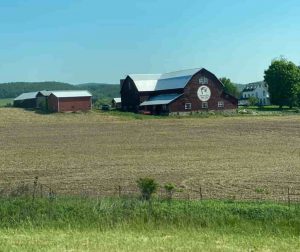
A charming Pennsylvania Wilds barn. [Photo by Ellen Rugh]
• Events – The PA Wilds Center does not play a direct role in routinely creating and hosting catalyst events, with the exception of a Buyer’s Market, a tradeshow for regional makers and businesses to promote their products to retailers in the Pennsylvania Wilds and the PA Wilds Conservation Shop. Instead, the Center has created partnerships with certain event organizers and will provide a platform for promoting events.
Community Engagement
PA Wilds Center works with local, state, and national partners from the public and private sectors. These include entrepreneurs, small businesses, corporate leaders, land and waterway managers, conservation organizations, non-profits, tourism and heritage, and economic developers. For example, the PA Wilds Center created an entrepreneurial ecosystem and business development program, Wilds Cooperative of Pennsylvania (WCO). The WCO includes a membership network of “creative makers” and place-based businesses. This arrangement contributes to the value-chain of local products and services tied to the PA Wilds lifestyle brand. Additionally, the PA Wilds Center has a process in place for collecting comments from people and partners in the PA Wilds that will help inform the work. By listening to community members’ feedback, the Center can work out any kinks in future programs and plans.
Managing Sustainability and Stewardship
Because of its unique natural resources, the Pennsylvania Wilds region is designated one of seven Conservation Landscapes in Pennsylvania. The PA Wilds Center works closely with the PA DCNR to coordinate activities by the many local partners involved in the conservation landscape work. This aims to grow nature and heritage tourism in the region while creating jobs, diversifying local economies, inspiring stewardship, and improving quality of life.
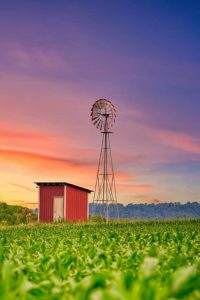
Building relationships with nearby farming communities enables businesses to source local food products. [Photo by Cameron Venti]
The PA Wilds Center goes beyond traditional destination marketing by taking action to be sustainable, such as making their buildings energy efficient. West Penn Power Sustainable Energy Fund (WPPSEF) has been a major investor in the PA Wilds. WPPSEF has helped fund energy-efficient upgrades to have high-performance buildings across the region. This collaboration shows that sustainable energy investments can drive local economic development in rural communities. The PA Wilds Center offers resources such as a brochure for both visitors and residents on (1) how to build energy-efficient visitor centers and (2) how to travel smarter while reducing their environmental impact. The PA Wilds Center and WPPSEF raise awareness about the difference energy-efficient technologies can have on the environment and on an organization’s bottom line. Their financing and grant programs help many communities in the region tackle such projects.
Every year, the PA Wilds Center recognizes outstanding local Conservation/Stewardship efforts through the PA Wilds Champion Awards program, honoring individuals, groups, organizations, communities, and businesses that made significant contributions toward nature tourism alongside economic development and conservation goals. The awards include Outstanding Leader Award, Conservation Stewardship Award, Artisan of the Year Award, Inspiring Youth Award, and Event of the Year.
The Center has no formalized language for explicitly de-emphasizing mass tourism. The council does claim that by promoting the authentic character of the vast rural and forested region, the area naturally lends itself to more individualized tourism experiences.
There are two components of PA Wilds Center’s organizational structure. The first is the PA Wilds Center for Entrepreneurship and the second is the PA Wilds Planning Team.
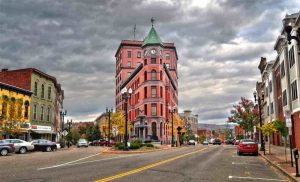
The unique architecture of the Warren Business District. [Photo courtesy of PA Wilds Center for Entrepreneurship Inc.]
Although it is still housed under the PA Wilds Center for Entrepreneurship, the Planning Team largely functions as its own entity. It encompasses a 13-county stakeholder group, giving local stakeholders a voice in the PA Wilds Center work. This group is made up of county planners and dozens of organizations from across the PA Wilds in addition to three executives: Chair, Vice Chair, and Treasurer/ Secretary. The Planning Team was formed in 2006 through an Intergovernmental Cooperative Agreement, largest of its kind in Pennsylvania. Under that agreement, the Planning Team shapes its own projects and has been the force behind the PA Wilds Champion Awards, the PA Wilds Design Guide for Community Character Stewardship, and the mini grant program. This team meets monthly to share information and to undertake activities that will capitalize on economic gains, without harming the region.
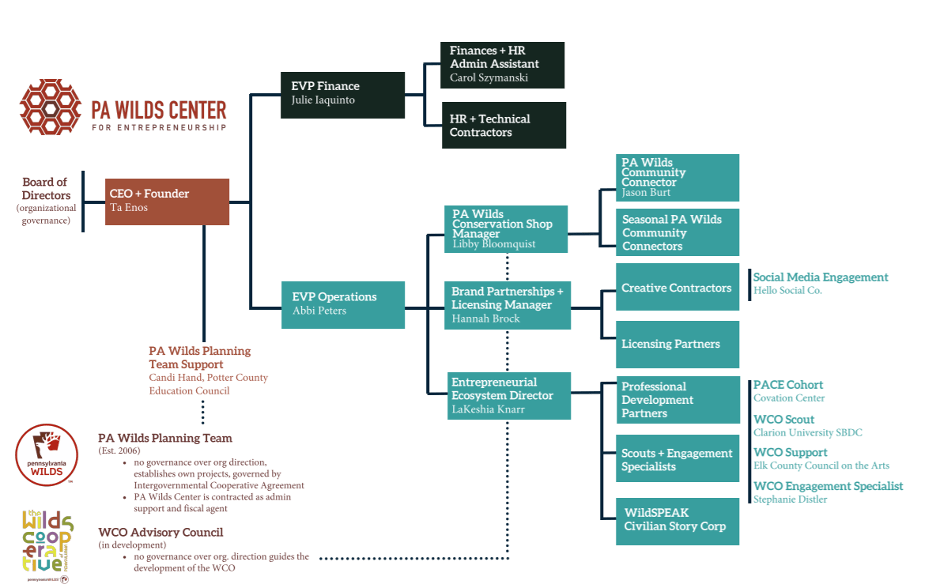
DIAGRAM: Source: PA Wilds Center @ https://www.pawildscenter.org/wp-content/uploads/2020/12/2020-PA-Wilds-Center-Org-Chart.pdf
Funding
Several core donors support the Center, including the Pennsylvania Department of Conservation & Natural Resources, PA Department of Community & Economic Development, the Appalachian Regional Commission, and the region’s 12 county governments. Additionally, the PA Wilds Center’s work is sustained through program fees, philanthropic giving, government grants, and entrepreneurial activities related to the Pennsylvania Wilds brand. As of June 30, 2018, the PA Wilds Center received $697, 720 in grants; $41, 572 from corporate, foundation, and individual contributions; and $210, 104 in program income. Between 2017 and 2019, the PA Wilds Center received more revenue than they spent on expenses. This non-profit seems well-funded, and based on the recent financial statements, the organization demonstrates stable funding.
In May 2020, the PA Wilds Center released a white paper entitled, “Early Impacts of COVID-19 on the rural Pennsylvania Wilds Initiative”. While the paper discusses funding challenges from local conservation groups and DMOs with PA Wilds’ territory, how COVID-19 has directly impacted PA Wilds Center’s organizational funding was not yet specified. Ta Enos, Chief Executive Officer of the PA Wilds Center, encouraged small businesses within the PA Wilds to apply for the COVID-19 Relief Statewide Small Business Assistance Program. This program provided grants ranging from $5,000 to $50,000 to small businesses with 25 or fewer employees and that have an annual gross revenue of $1 million or less.
Things could have been worse. The pandemic actually resulted in a 22% increase in state park visitation, as tourist sought the relative safety of outdoor experiences. “We’re in a position for a strong recovery, because of the kind of destination that we are, because we are rural, we are outdoor based. Coming out of this crisis, people are kind of looking for those experiences,” Enos told local TV station WPSU. “The pandemic has not slowed that at all, the overall scope of what we’re trying to accomplish in the long term. If anything, it’s sped it up. I think it’s shone a new light onto it.”
Measures of Success
The PA Wilds Center uses metrics generated both in-house and by their partners to measure success. Some of the in-house indicators include the number of members in the WCO, multiple revenue streams, Conservation Shop sales, and employment statistics from the WCO. Additionally, other data sources come from reports generated by the US forest service, state tourism office, and the PA DCNR.
Some highlights include:
- Overnight visitor trips to the Wilds grew 57% from 2010-2015
- From 2009-2016:
- visitor spending in the region grew an average of 37%
- tourism employment increased by 19%
Beyond these basic metrics, the PA Wilds Center has a guiding strategy known as BUDS:
- BRING visitors to the region to boost local economies, attract investment, and improve quality of life;
- UNIFY partners around the PA Wilds Work;
- DELIVER programs and services to our businesses and communities; and
- STEWARD our region’s public lands and natural assets, rural lifestyle, and unique community character, while sustaining our organization and vision for future generations.
Each of the four function areas has six to nine key performance indicators (KPIs) used to guide and track progress both short term (< 3 years) and long-term (10-30 years). A KPI under Unify, for instance, is to have 2,000 small businesses participating in the WCO annually within the next 10 years. A KPI under their Steward strategy is to raise $25,000 annually for conservation through their charity checkout campaign at the PA Wilds Conservation Shop. The KPIs are not set in stone and are reviewed annually to ensure they are still relevant, essential for post-pandemic planning. To learn more about PA Wilds Center’s KPIs, download their Strategic Plan.
Commentary
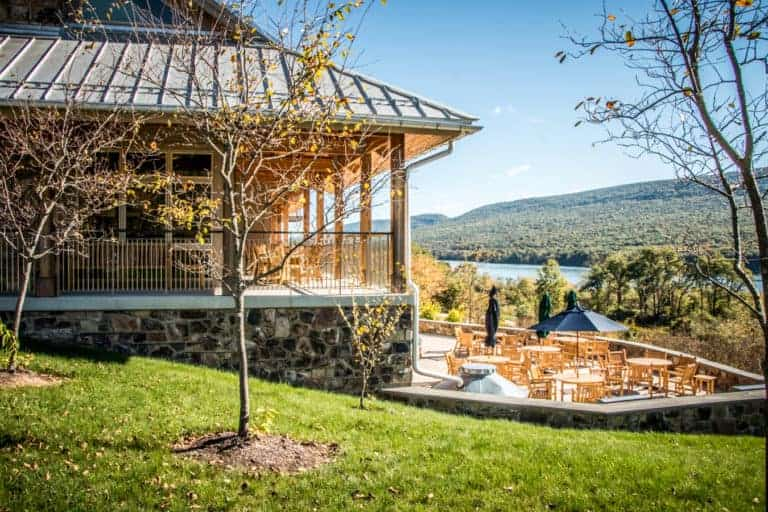
The Nature Inn at Bald Eagle State Park incorporates Design Guide principles of green technology and local artisan products into its building design. [Photo courtesy of PA Wilds Center for Entrepreneurship Inc.]
The PA Wilds Center is also proficient in its engagement with local businesses. It is rewarding to see a non-profit source all the products in its gift shops from local businesses, thereby keeping money in the rural economy, supporting local jobs and entrepreneurs, leaving a smaller energy footprint, strengthening community ties, and finally, giving tourists something unique to bring home and better remember their trip. Since the Conservation Shop opened in August 2016, the high demand for regionally made products has generated more than $1 million in sales. The PA Wilds Center demonstrates how buying local is a great way to support the community, complete with tourist support.
One concern regards the apparent lack of a succession plan. Even though the organization is fortunate to have full-time staff and stable funding, it is vital for it to have a plan to pass on the reins and ensure the continuation of its sustainability efforts. A succession plan allows for a smooth transition if any individual in a leadership role (including the Chief Executive Officer) must part ways with the organization. With no succession plan in place this wonderful example of a functioning destination stewardship may not be able to capitalize long-term on their tourism achievements.
It is often a challenge for environmental organizations (especially in rural areas) to be adequately funded. However, the PA Wilds Center has had a stable funding stream over recent years. One hopes this will help the organization continue to make great strides in the environmental conservation field despite the pandemic in 2020. If this region continues to bounces back quickly, it will show that more organizations should adopt a mission to integrate conservation and economic development in a way that strengthens and inspires both communities and their visitors.
We welcome your comments on the PA Wilds Center and its stewardship.
About DSR Contributors
Volunteer contributors are welcome to the Destination Stewardship Report. Contact us with your proposals and ideas.


